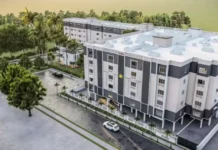Despite the many innovations and alternative roofing solutions, built-up (BUR) systems are still one of the most popular choices for commercial roofs. BUR systems are durable, puncture-resistant, and offer fire resistance.
The essential components of a BUR system include felt layers, bitumen layers, and surfacing materials. Felt is a fiber-reinforced material that provides tensile strength to the roof. The bitumen, coal tar, or asphalt is the ‘glue’ holding the felt layers together.
Cost
Although it is more expensive to install than shingles, a built-up roofing system offers excellent waterproofing and ultraviolet protection. This makes it an affordable choice for many buildings. Additionally, it is a fire-resistant roof system that can last 15 to 30 years with minimal maintenance costs.
A build-up roof typically requires a new layer every four to six years and should be inspected at least once a year by a roofing professional. However, it is less expensive than a traditional roof because it has fewer parts that need to be replaced.
The layered structure of a BUR system provides insulation for the building, which can reduce energy costs. The reflective qualities of the BUR can also lower a building’s cooling costs and help it stay at a more consistent temperature. These features make a BUR an attractive, cost-effective roofing solution for many commercial buildings. However, you should always check your local building codes to ensure that this type of roof meets all requirements for your area.
Maintenance
A built-up roof has multiple layers of protection, so it’s durable against damage. The first layer is a high-strength base sheet to prevent cracks or splits. Then, commercial roofing companies add alternating layers of asphalt and felt to form a protective membrane. These backup layers offer fire resistance, physical durability, and water repellency.
Depending on the climate, built-up roofs can last up to 40 years. However, they do require periodic maintenance. For example, they must be coated every four to six years. They also need to be inspected at least once a year.
Leaks in a built-up roof are difficult to detect because of the many layers. If not addressed immediately, it can cause significant and costly structural damage. In addition, these leaks can be exacerbated by the hot-cold expand-and-contract cycle. Therefore, finding Chicagoland roofing experts to service your built-up roof is crucial. This ensures that the repairs are completed properly and to your satisfaction.
Lifespan
The lifespan of built-up roofing systems — tar and gravel roofs — depends on the specific materials used and the climate. Generally, they last more than a decade and are very durable. These roofs are also great insulators and can help save you money by keeping your building’s interior temperature consistent.
However, there are some disadvantages to consider when evaluating this type of roofing system for your commercial or industrial property. First, it can be a long process to install. Roofers must use gas torches or kettles to heat the asphalt until it becomes liquid. This can be dangerous and take a while.
Another disadvantage is pondering water can build up on the roof, leading to a sagging roof section. This may need to be repaired, which can increase the overall cost of the system. Finally, the roof can emit toxic fumes during the installation process.
Installation
Built-up roofs are typically installed by hand, so that they can be more time-consuming than other roofing types. Nevertheless, they are one of the most durable roofing systems available for commercial and industrial buildings. However, thoroughly vet contractors before hiring a contractor for a built-up roof installation or replacement.
A BUR roof consists of alternating felt sheets, asphalt, and gravel layers. The felt layers are usually made of reinforced fabric, fiberglass, or organic materials that bond with the asphalt through a hot or cold process. The surfacing is then covered with a flood coat of asphalt and granules. The multiple layers of protection provide redundancy, making BUR roofs resilient to weather and physical damage.
This type of roof also offers traction, which is especially useful for facilities with foot traffic. Because the surfacing is comprised of gravel, built-up roofs are slip-resistant. Furthermore, the roof layers are thermally efficient and can help lower a facility’s heating or cooling costs.










![Anso FG Reviews: UPDATED 2024 [ansofg.com] Anso FG Reviews UPDATED 2024 [ansofg.com]](/wp-content/uploads/2023/12/Anso-FG-Reviews-UPDATED-2024-ansofg.com_-100x70.png)







